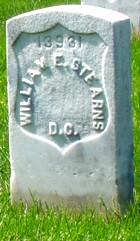Bill Stearns
| Date and Place of Birth: | March 20, 1853 Washington, DC |
| Date and Place of Death: | December 30, 1898 Washington, DC |
| Baseball Experience: | National Association |
| Position: | Pitcher |
| Rank: | Private |
| Military Unit: | Company H, First District of Columbia Volunteers US Army |
| Area Served: | Puerto Rico |
Bill Stearns was a veteran of the American Civil War, a pitcher in the first professional baseball league and a volunteer during the Spanish-American War.
William E. “Bill” Stearns was born on March 20, 1853 in Washington,
DC. Despite being only 12 years old at the end of the American Civil
War, he served in that conflict in some capacity. Thousands of boys and
girls participated in the Civil War as drummers, messengers, hospital
orderlies, and often as fully fledged soldiers. They carried canteens,
bandages, and stretchers, and assisted surgeons and nurses. Exactly what
Stearns role was I do not know, but as a member of the Grand Army of the
Republic (a fraternal organization composed of veterans of the American
Civil War), he certainly was involved.
The American Civil War had ended six years earlier and baseball was
still very much in its infancy when the National Association was founded
in 1871. This was the era of Al Spalding and Harry Wright. Bill Stearns,
just 18 years old, pitched for the Washington Olympics that year. He
only made two appearances (Asa Brainard pitched the other 30 games the
Olympics played that season) but won them both, beating Cleveland 16-3
on June 26 and Chicago 13-8 on June 30.
In 1872, he pitched for the National Association’s Washington Nationals,
completing all 11 of the team’s games and losing them all. In 1873, with
the Washington Blue Legs he managed 7 wins but this was eclipsed with 25
losses. He spent 1874 with the Hartford Dark Blues and was 3-14, then
posted a 1-14 record with the Washington Nationals in 1875 – the last
year of the National Association.
The National League replaced the National Association in 1876 and
Stearns was never seen again in professional baseball. He finished his
career with a 13-64 won-loss record and 4.28 ERA in 84 games.
More than 20 years later, 45-year-old Bill Stearns volunteered for
military service with the outbreak of the Spanish-American War in 1898.
He served as a private with Company H, First District of Columbia
Volunteers; a provisional engineering unit that trained in military
engineering procedures for thePuerto Rico expedition. They engaged in
drills with pontoon trains, building bridge piers, building rafts, and
loading and unloading field artillery onto rafts and boats.
On July 11, 1898, Company H boarded the transport ship Lampasas, and
embarked for Key West, where they engaged in target practice. Guantanamo
was the next stop where they built and dismantled piers, and loaded
materials. They arrived in Guanica Harbor, Puerto Rico on July 25, and
at the request of Commander Wainwright of the USS Gloucester,
disembarked into the town, with a detachment of artillery, to clear the
vicinity of Spanish troops. This was the first landing of the US Army in
Puerto Rico. During the passage to the shore from the ship, the
battalion was warned to be prepared to come under fire from the Spanish.
The town was occupied by 300 Spanish troops and a skirmish line was
formed and advanced, causing the Spanish troops to flee. The Americans
then established outposts on the range of hills overlooking the bay.
Company H, under command of Captain Looker, remained at Guanica, where
the engineers constructed piers and roads, and landed the engineering
stores of the expedition.
Stearns became ill during his time in Puerto Rico and was excused from
all but light duties. One account referred to it as “poisoning of his
stomach.”
On September 16, 1898, three weeks after arriving in Puerto Rico,
Company H arrived back in United States aboard the transport Alamo. The
three day voyage had been almost unbearable for the 500 men aboard,
which certainly would have been difficult for an already ailing Bill
Stearns. Apart from severe overcrowding and virtually inedible food,
they encountered severe storms along the way.
Bill Stearns never recovered from his illness. In late December 1898,
his conditioned worsened at his home in Washington, DC, and he died on
December 30. His funeral was held on January 1, 1899, with Captain
Looker and many men from Company H in attendance. As a member of the
Grand Army of the Republic, a large number of his former Civil War
comrades were also present. He is buried at Arlington National Cemetery
in Arlington, Virginia.
Sources
New York Times July 1, 1871
New York Times Sept 17, 1898
Washington Post Dec 31, 1898
Date Added July 14, 2012
Baseball's Greatest Sacrifice is associated with Baseball Almanac
Baseball's Greatest Sacrifice is proud to be sponsored by

